Cephalopod intelligence

Cephalopod intelligence has an important comparative aspect in the understanding of intelligence because it relies on a nervous system fundamentally different from that of vertebrates.[1] The cephalopod class of molluscs, particularly the Coleoidea subclass (cuttlefish, squid, and octopuses), are thought to be the most intelligent invertebrates and an important example of advanced cognitive evolution in animals.
The scope of cephalopod intelligence is controversial, complicated by the challenges of studying these elusive and fundamentally different creatures. In spite of this, the existence of impressive spatial learning capacity, navigational abilities, and predatory techniques in cephalopods is widely acknowledged.[2]
Examples
Predation techniques
Unlike most other molluscs, all cephalopods are active predators (with the possible exception of the bigfin squid and vampire squid). Their requirement to locate and capture their prey has been a probable driving force behind the development of their intelligence, uniquely advanced among molluscs.
The Humboldt squid hunts schools of fish, showing extraordinary cooperation and communication in its hunting techniques. This is the first observation of such behaviour in invertebrates.[3]
Crabs, the staple food source of most octopus species, present significant challenges with their powerful pincers and their potential to exhaust the cephalopod's respiration system from a prolonged pursuit. In the face of these challenges, octopuses will instead seek out lobster traps and steal the bait inside. They are also known to climb aboard fishing boats and hide in the containers that hold dead or dying crabs.[4]
Dexterity
Dexterity, an ability essential for tool use and manipulation, is also found in cephalopods. The highly sensitive suction cups and prehensile arms of octopuses, squid, and cuttlefish are as effective at holding and manipulating objects as the human hand. However, unlike vertebrates, the motor skills of octopuses do not seem to depend upon mapping their body within their brains, as the ability to organize complex movements is not thought to be linked to particular arms.[5]
At the Sea Star Aquarium in Coburg, Germany, an octopus named Otto was known to juggle his fellow tankmates around, as well as throw rocks and smash the aquarium glass. On more than one occasion, Otto even caused short circuits by crawling out of his tank and shooting a jet of water at the overhead lamp.[6]
- Octopus opening a container with a screw cap
-

-

-

-

Communication
Another example of cephalopod intelligence is the communication that takes place between the more social species of squid.[7] Some cephalopods are capable of rapid changes in skin color and pattern through nervous control of chromatophores.[8] This ability almost certainly evolved primarily for camouflage, but squid use color, patterns, and flashing to communicate with one another in various courtship rituals.[7] Caribbean reef squid can send one message via color patterns to a squid on their right, while they send another message to a squid on their left.[9][10]
Tool use

The octopus is one of the prime examples of an invertebrate animal which has repeatedly been shown to exhibit flexibility in its use of tools. At least four specimens of the veined octopus (Amphioctopus marginatus) have been witnessed retrieving discarded coconut shells, manipulating them, transporting them some distance, and then reassembling them to use as a shelter.[11] It is surmised that the octopuses originally used bivalves for the same purpose, before humans made coconut shells widely available on the sea floor.[12][13] Most hermit crabs use discarded shells of other species for habitation and other crabs choose sea anemones to cultivate on their carapaces as camouflage; numerous insects use rocks, sand, leaves and so on as building materials; however, none of this behavior compares to the complexity of the octopus's fortress behavior, which involves picking up and carrying a tool to use later on.[14]
Learning
Classical conditioning of cephalopods has been reported, and one study (Fiorito and Scotto, 1992) even concluded that octopuses practice observational learning.[15] However, the latter idea is disputed.[16][17]
Brain-to-body ratio
Cuttlefish and octopus have the highest brain-to-body mass ratios of all invertebrates.[18]
Protective legislation
Due to their intelligence, cephalopods are commonly protected by animal testing regulations that do not usually apply to invertebrates.
In the UK from 1993 to 2012, the common octopus (Octopus vulgaris) was the only invertebrate protected under the Animals (Scientific Procedures) Act 1986.[19]
Cephalopods are the only invertebrates protected under the 2010 European Union directive "on the protection of animals used for scientific purposes".[20]
See also
References
- ↑ "Cephalopod intelligence" in The Encyclopedia of Astrobiology, Astronomy, and Spaceflight.
- ↑ "Inky the Octopus Escapes From a New Zealand Aquarium". NYT. Retrieved 2016-04-24.
- ↑ Behold the Humboldt squid. Tim Zimmermann, Outside Magazine, July 2006.
- ↑ Cousteau, Jacques Yves (1978). Octopus and Squid: The Soft Intelligence
- ↑ Zullo, L; Sumbre, G; Agnisola, C; Flash, T; Hochner, B. (2009). "Nonsomatotopic organization of the higher motor centers in octopus". Curr Biol. 19 (19): 1632–6. doi:10.1016/j.cub.2009.07.067. PMID 19765993.
- ↑ "Otto the Octopus wreaks havoc"
- 1 2 Brown, C; Garwood, M. P.; Williamson, J. E. (2012). "It pays to cheat: Tactical deception in a cephalopod social signalling system". Biology Letters. 8 (5): 729–32. doi:10.1098/rsbl.2012.0435. PMC 3440998
 . PMID 22764112.
. PMID 22764112. - ↑ Cloney, R.A.; Florey, E. (1968). "Ultrastructure of cephalopod chromatophore organs". Z Zellforsch Mikrosk Anat. 89 (2): 250–280. doi:10.1007/BF00347297. PMID 5700268.
- ↑ "''Sepioteuthis sepioidea'', Caribbean Reef squid". The Cephalopod Page. Retrieved 2010-01-20.
- ↑ Byrne, R.A., U. Griebel, J.B. Wood & J.A. Mather 2003. "Squids say it with skin: a graphic model for skin displays in Caribbean Reef Squid." (PDF). (3.86 MB) Berliner Geowissenschaftliche Abhandlungen 3: 29–35.
- ↑ Finn, J. K.; Tregenza, T.; Tregenza, N. (2009). "Defensive tool use in a coconut-carrying octopus". Current Biology. 19 (23): R1069–R1070. doi:10.1016/j.cub.2009.10.052. PMID 20064403.
- ↑ Morelle, Rebecca (2009-12-14). "Octopus snatches coconut and runs". BBC News. Retrieved 2010-01-20.
- ↑ "Coconut shelter: evidence of tool use by octopuses | EduTube Educational Videos". Edutube.org. 2009-12-14. Retrieved 2010-01-20.
- ↑ https://www.youtube.com/watch?v=hlh0cS2tf24
- ↑ Fiorito, Graziano; Scotto, Pietro (24 April 1992). "Observational Learning in Octopus vulgaris" (PDF). Science. 256 (5056): 545–547. doi:10.1126/science.256.5056.545. Retrieved 18 February 2015.
- ↑ Hamilton, Garry (7 June 1997). "What is this octopus thinking?". New Scientist (2085). pp. 30–35. Retrieved 18 February 2015.
- ↑ Is the octopus really the invertebrate intellect of the sea? by Doug Stewart. In: National Wildlife. Feb/Mar 1997, vol.35 no.2
- ↑ NOVA: Kings of camouflage. Film Finance Corporation Australia Limited & Kaufmann Productions; WGBH. 2007.
- ↑ "The Animals (Scientific Procedures) Act (Amendment) Order 1993". The National Archives. Retrieved 18 February 2015.
- ↑ "DIRECTIVE 2010/63/EU OF THE EUROPEAN PARLIAMENT AND OF THE COUNCIL". Article 1, 3(b): Official Journal of the European Union. Retrieved 18 February 2015.
Further reading
- So you think you're smarter than a cephalopod? by Wendy Williams, At the Smithsonian's Ocean Portal.
- What behavior can we expect of octopuses? by Dr. Jennifer Mather, Department of Psychology and Neuroscience, University of Lethbridge and Roland C. Anderson, The Seattle Aquarium.
- Is the octopus really the invertebrate intellect of the sea? by Doug Stewart. In: National Wildlife. Feb/Mar 1997, vol.35 no.2.
- Giant Octopus — Mighty but Secretive Denizen of the Deep from the National Zoo in Washington D.C.
- Living Fossils Have Long- And Short-term Memory Despite Lacking Brain Structures Of Modern Cephalopods
- M.J. Wells (1962). Brain and Behaviour in Cephalopods. Heinemann.
- Roger T. Hanlon & John B. Messenger (1996). Cephalopod Behaviour. Cambridge University Press. ISBN 0-521-42083-0.
- Marion Nixon and John Z. Young (2003). The Brains and Livees of Cephalopods. Oxford University Press.
- Binyamin Hochner; Tal Shomrat; Graziano Fiorito (June 1, 2006). "The Octopus: A Model for a Comparative Analysis of the Evolution of Learning and Memory Mechanisms". The Biol. Bull. 210 (3): 308–817. PMID 16801504.
- Octopuses are Smart Suckers!? By Dr. Jennifer Mather, Department of Psychology and Neuroscience, University of Lethbridge and Roland C. Anderson, The Seattle Aquarium
- Through the Eye of an Octopus, by Eric Scigliano, Discover Magazine, October 1, 2003.
- The Diversity and Evolution of Invertebrate Nervous Systems Set Institute. Retrieved 12 December 2014.